Das Mirakel (The Miracle) is a German play written by Karl Vollmöller in 1911. That same year Max Reinhardt staged a spectacle-pantomime in Berlin. Later, three films were made. But for which stage or film version of Das Mirakel were the postcards in this post created?
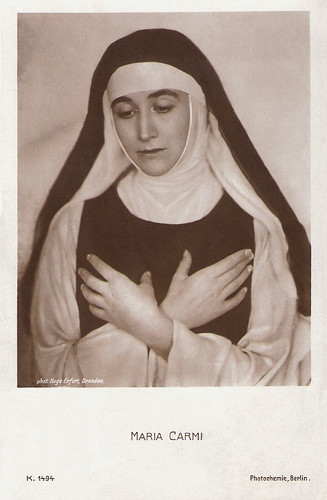
German postcard by Photochemie, Berlin, no. K. 1494. Photo: Hugo Erfurt, Dresden. Maria Carmi. This card may refer to the film Das Wunder der Madonna (Walter Schmidthässler, Robert Reinert, Deutsche Bioscop, 1915-1916), but it could also refer to Carmi's popular stage play 'Das Mirakel' (The Miracle) by Max Reinhardt, staged first in 1911 (after which many reprisals followed), and filmed twice in 1912.
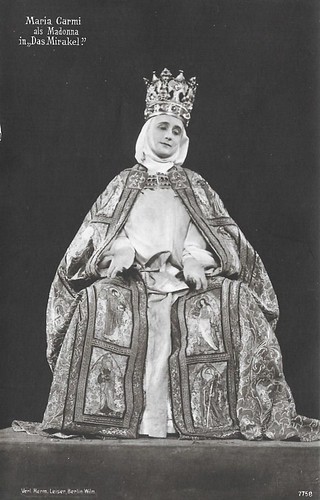
German postcard by Verlag Hermann Leiser, Berlin-Wilmersdorf, no. 7758. Publicity still for The Miracle (1912) with Maria Carmi. Collection: Didier Hanson.
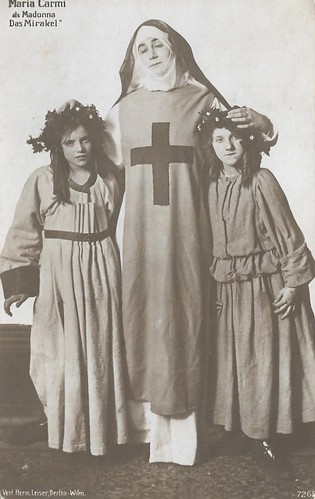
Maria Carmi. German postcard by Verlag Hermann Leiser, Berlin-Wilmersdorf, no. 7268. Publicity still for The Miracle. Collection: Didier Hanson.
Das Mirakel (The Miracle) first appeared as a spectacle-pantomime in Germany in 1911. Later in 1911, the play also opened in London and played to huge audiences at the Olympia, the London exhibition hall.
Das Mirakel re-tells an old legend about a nun in the Middle Ages who runs away from her convent with a knight. She has several adventures, eventually leading to her being accused of witchcraft. During her absence, the statue of the Virgin Mary in the convent's chapel comes to life and takes the nun's place in the convent, until her safe return. Then she becomes a statue again.
The play's stage director was Max Reinhardt, the Austrian theatrical genius, whose inspired use of lighting, mechanical effects, and spectacle (particularly crowds) startled audiences across Europe. He told the story of Das Mirakel without words in a cathedral setting. 1,000 performers and 500 choristers and 25 horses filled out the epic drama, supported by a wonderful array of stage mechanics, ingenious theatrical effects, and music of the great composer Engelbert Humperdink played by an orchestra of 2,000. For many, the spectacular Das Mirakel was a theatrical event like no other.
Das Mirakel launched the career of Italian silent film star and stage actress Maria Carmi (1880-1957), who interpreted the virgin, Mary. With her aristocratic air, her severe looks but also her sweet undertones, Carmi was the cinematic translation of the 19th-century Primadonna. Later she became Princess Norina Matchabelli and was co-founder of the perfume company Prince Matchabelli.
In 1924, Das Mirakel was revived on Broadway, after a tour of Detroit, Milwaukee, and Dallas. The New York version, which opened on 16 January 1924 at the Century Theatre was produced by Morris Gest and starred Rosamond Pinchot as the Nun, and Lady Diana Cooper and Maria Carmi alternating nightly in the role of the Madonna.
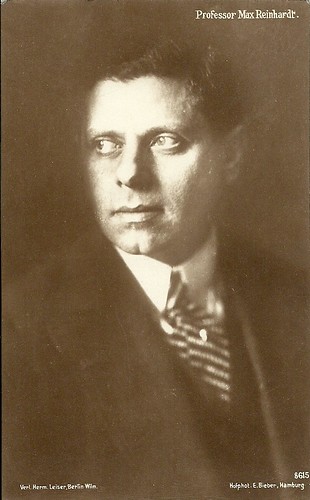
Max Reinhardt. German postcard by Verlag Hermann Leiser, Berlin, no. 8615. Photo: Hofphot. E. Bieber, Hamburg. Collection: Didier Hanson.
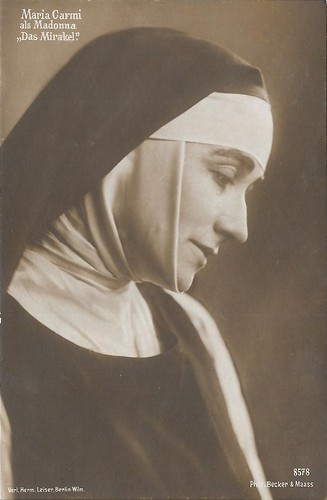
Maria Carmi. German postcard by Verlag Hermann Leiser, Berlin-Wilmersdorf, no. 8578. Photo: Becker & Maass. Publicity still for Das Mirakel/The Miracle. Collection: Didier Hanson.
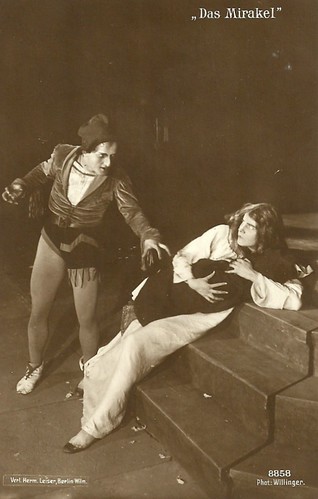
German postcard by Verlag Hermann Leiser, Berlin, no. 8858. Photo: Willinger. German postcard for either the stageplay 'Das Mirakel' (1911) or the Austrian-British film Das Mirakel/The Miracle (1912). The postcard shows Ernst Matray as the Evil Genius and probably Florence Winston as Megildis, the nun who has escaped the convent and now has a baby.
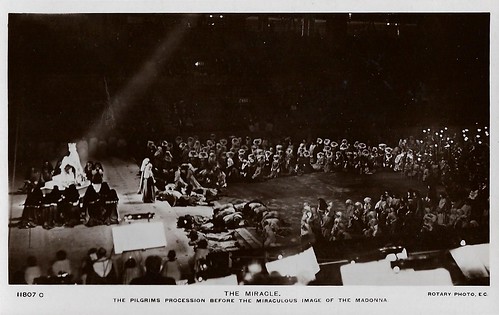
British postcard by Rotary Photo, no. E.C. 11807 C. Maria Carmi in the Joseph Menchen play 'The Miracle'. Caption: The pilgrims procession before the miraculous image of the madonna.
Das Mirakel/The Miracle was adapted to three different film versions. The original authorised version, The Miracle (1912), was a full-length, hand-coloured film, which was shot in Austria in 1912 but was a British production. The exteriors were photographed on the grounds of Kreuzenstein Castle and at the cathedral of Perchtoldsdorf, Vienna.
The Miracle (1912) was produced by Joseph Menchen and (probably) directed by French actor, stage director, and film director Michel Carré, who also wrote the screenplay. IMDb wrongly suggests the film is called Das Mirakel and was directed by wildlife filmmaker Cherry Kearton and by Max Reinhardt himself. Reinhardt had little to do with the film’s actual production.
The stars were Maria Carmi as The Madonna, Ernst Matray as Spielmann (the minstrel), and Florence Winston as the Nun. The Hungarian Matray was an acclaimed stage actor, who had been playing with Max Reinhardt's Deutsches Theater since 1907.
Instead, the British Florence Winston was an unknown actress. In the stage version, her role had been played by someone else. According to Luke McKernan at his site The Bioscope, Winston's only claim to fame was that she was the wife of William Jeapes, one of the film's cinematographers, together with his brother Harold. The two brothers were known as newsreel cinematographers. William Jeapes ran the popular British newsreel Topical Budget, but nothing is known about whether they had any previous experience of fiction film making.

German postcard by Verlag Hermann Leiser, Berlin, no. 8556. Photo: Willinger. Publicity still for either the stage play Das Mirakel (1911) or the Austrian-British film Das Mirakel/The Miracle (1912).
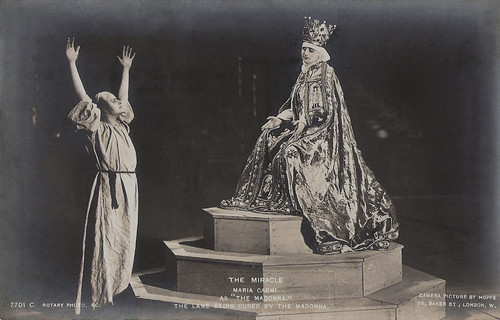
British postcard by Rotary Photo, no. 7701 C. Photo: Hoppe, London. Publicity still of the London stage production of Das Mirakel/The Miracle (Max Reinhardt, 1912) with Maria Carmi as the Madonna. Here she has just cured the lame.
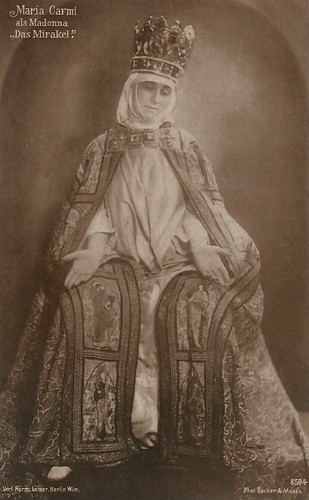
Maria Carmi. German postcard by Verlag Hermann Leiser, Berlin-Wilmersdorf, no. 8594. Photo: Becker & Maass.
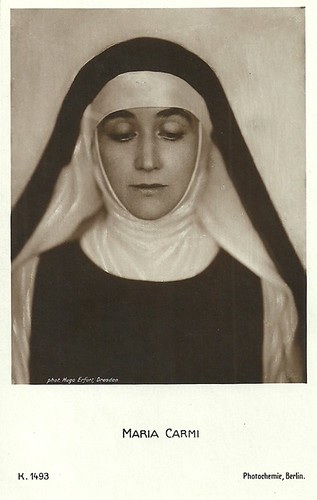
German postcard by Photochemie, no. K. 1493. Photo: Hugo Erfurt, Dresden. This card may refer to the film Das Wunder der Madonna (Walter Schmidthässler, Robert Reinert, Deutsche Bioscop, 1915-1916), but it could also refer to Carmi's popular stage play 'Das Mirakel' (The Miracle) by Max Reinhardt, staged first in 1911 (after which many reprisals followed), and filmed twice in 1912.
The Miracle (Michel Carré, 1912) was not intended to be shown as an ordinary film in the usual way, but was designed by Joseph Menchen to be shown as part of a 'Lyricscope play'. This was an unusual (if not unique) spectacular theatrical presentation which - in its most elaborate and complete expression - included: the projected colour film, a full-sized symphony orchestra and chorus, live sound effects such as church bells and crowd noises, stage sets around the projection screen which changed during the performance and live (non-speaking) actors and dancers in medieval costume.
Joseph Menchen was a London-based American inventor, film projectionist, and owner of a New York theatrical lighting business. He later became a literary agent for film scripts. The various component parts of his production of Das Mirakel varied somewhat according to local conditions.
The world premiere took place at the Royal Opera House, Covent Garden, London, on 21 December 1912. It was released in Germany in August 1914 and premiered at the Circus Busch.
In 1912 an unauthorised German version was also filmed, titled Das Mirakel. It was directed by Mime Misu for Continental-Kunstfilm in Germany. Mime Misu was a Romanian who had come to prominence in German cinema following the success of his dramatisation of the tragic story of the sinking of the ‘Titanic’, In Nacht und Eis/In night and ice (1912). Misu has not only directed the film but acts in it as well, alongside Lore Giesen and Ernst Rückert. The production was the subject of various copyright legal actions in the UK and the USA, resulting in seven different titles shared between the two films.
In 1959 the play was adapted to film a third time by Warner Brothers, again titled The Miracle, directed by Irving Rapper.
The first film version, The Miracle (Michel Carré, 1912) was considered lost for a long time. A tinted print was discovered and saved in recent times at the CNC in Bois d'Arcy. At the time, The Miracle was a prestigious production, but nowadays it fails to capture this. This is because of its antiquated style, even for 1912, but also because of the lack of the multimedia experience around its original showings.
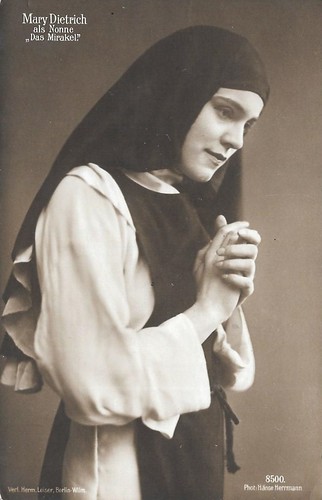
German postcard by Verlag Hermann Leiser, Berlin-Wilmersdorf, no. 8500. Photo: Hänse Hermann. Publicity still for Das Mirakel/The Miracle with Mary Dietrich. Collection: Didier Hanson.
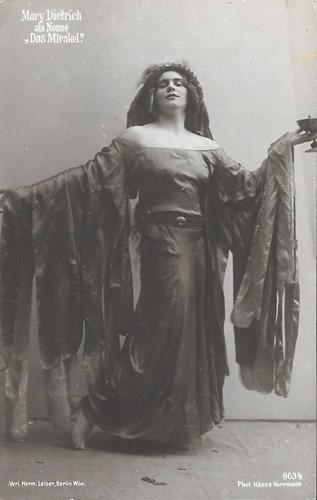
German postcard by Verlag Hermann Leiser, Berlin-Wilmersdorf, no. 8634. Photo: Hänse Hermann. Publicity still for Das Mirakel/The Miracle with Mary Dietrich. Collection: Didier Hanson.
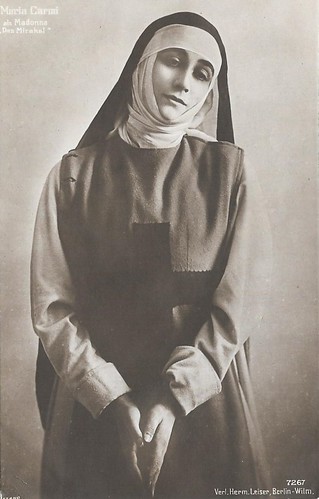
Maria Carmi. German postcard by Verlag Hermann Leiser, Berlin-Wilmersdorf, no. 7267. Collection: Didier Hanson.
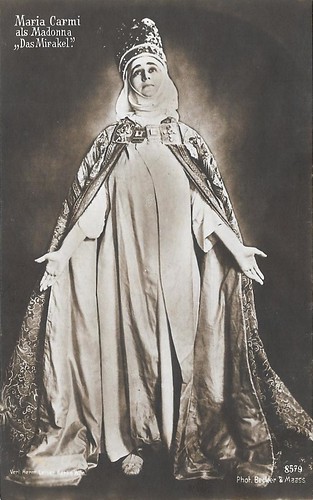
German postcard by Verlag Hermann Leiser, no. 8579. Photo: Becker & Maass. Publicity still for Das Mirakel/The Miracle with Maria Carmi as the Madonna.
Sources: Luke McKernan (The Bioscope), Wikipedia and IMDb.
This post was last updated on 11 June 2021.

German postcard by Photochemie, Berlin, no. K. 1494. Photo: Hugo Erfurt, Dresden. Maria Carmi. This card may refer to the film Das Wunder der Madonna (Walter Schmidthässler, Robert Reinert, Deutsche Bioscop, 1915-1916), but it could also refer to Carmi's popular stage play 'Das Mirakel' (The Miracle) by Max Reinhardt, staged first in 1911 (after which many reprisals followed), and filmed twice in 1912.

German postcard by Verlag Hermann Leiser, Berlin-Wilmersdorf, no. 7758. Publicity still for The Miracle (1912) with Maria Carmi. Collection: Didier Hanson.

Maria Carmi. German postcard by Verlag Hermann Leiser, Berlin-Wilmersdorf, no. 7268. Publicity still for The Miracle. Collection: Didier Hanson.
Spectacle-pantomime
Das Mirakel (The Miracle) first appeared as a spectacle-pantomime in Germany in 1911. Later in 1911, the play also opened in London and played to huge audiences at the Olympia, the London exhibition hall.
Das Mirakel re-tells an old legend about a nun in the Middle Ages who runs away from her convent with a knight. She has several adventures, eventually leading to her being accused of witchcraft. During her absence, the statue of the Virgin Mary in the convent's chapel comes to life and takes the nun's place in the convent, until her safe return. Then she becomes a statue again.
The play's stage director was Max Reinhardt, the Austrian theatrical genius, whose inspired use of lighting, mechanical effects, and spectacle (particularly crowds) startled audiences across Europe. He told the story of Das Mirakel without words in a cathedral setting. 1,000 performers and 500 choristers and 25 horses filled out the epic drama, supported by a wonderful array of stage mechanics, ingenious theatrical effects, and music of the great composer Engelbert Humperdink played by an orchestra of 2,000. For many, the spectacular Das Mirakel was a theatrical event like no other.
Das Mirakel launched the career of Italian silent film star and stage actress Maria Carmi (1880-1957), who interpreted the virgin, Mary. With her aristocratic air, her severe looks but also her sweet undertones, Carmi was the cinematic translation of the 19th-century Primadonna. Later she became Princess Norina Matchabelli and was co-founder of the perfume company Prince Matchabelli.
In 1924, Das Mirakel was revived on Broadway, after a tour of Detroit, Milwaukee, and Dallas. The New York version, which opened on 16 January 1924 at the Century Theatre was produced by Morris Gest and starred Rosamond Pinchot as the Nun, and Lady Diana Cooper and Maria Carmi alternating nightly in the role of the Madonna.

Max Reinhardt. German postcard by Verlag Hermann Leiser, Berlin, no. 8615. Photo: Hofphot. E. Bieber, Hamburg. Collection: Didier Hanson.

Maria Carmi. German postcard by Verlag Hermann Leiser, Berlin-Wilmersdorf, no. 8578. Photo: Becker & Maass. Publicity still for Das Mirakel/The Miracle. Collection: Didier Hanson.

German postcard by Verlag Hermann Leiser, Berlin, no. 8858. Photo: Willinger. German postcard for either the stageplay 'Das Mirakel' (1911) or the Austrian-British film Das Mirakel/The Miracle (1912). The postcard shows Ernst Matray as the Evil Genius and probably Florence Winston as Megildis, the nun who has escaped the convent and now has a baby.

British postcard by Rotary Photo, no. E.C. 11807 C. Maria Carmi in the Joseph Menchen play 'The Miracle'. Caption: The pilgrims procession before the miraculous image of the madonna.
A full-length, hand-coloured film
Das Mirakel/The Miracle was adapted to three different film versions. The original authorised version, The Miracle (1912), was a full-length, hand-coloured film, which was shot in Austria in 1912 but was a British production. The exteriors were photographed on the grounds of Kreuzenstein Castle and at the cathedral of Perchtoldsdorf, Vienna.
The Miracle (1912) was produced by Joseph Menchen and (probably) directed by French actor, stage director, and film director Michel Carré, who also wrote the screenplay. IMDb wrongly suggests the film is called Das Mirakel and was directed by wildlife filmmaker Cherry Kearton and by Max Reinhardt himself. Reinhardt had little to do with the film’s actual production.
The stars were Maria Carmi as The Madonna, Ernst Matray as Spielmann (the minstrel), and Florence Winston as the Nun. The Hungarian Matray was an acclaimed stage actor, who had been playing with Max Reinhardt's Deutsches Theater since 1907.
Instead, the British Florence Winston was an unknown actress. In the stage version, her role had been played by someone else. According to Luke McKernan at his site The Bioscope, Winston's only claim to fame was that she was the wife of William Jeapes, one of the film's cinematographers, together with his brother Harold. The two brothers were known as newsreel cinematographers. William Jeapes ran the popular British newsreel Topical Budget, but nothing is known about whether they had any previous experience of fiction film making.

German postcard by Verlag Hermann Leiser, Berlin, no. 8556. Photo: Willinger. Publicity still for either the stage play Das Mirakel (1911) or the Austrian-British film Das Mirakel/The Miracle (1912).

British postcard by Rotary Photo, no. 7701 C. Photo: Hoppe, London. Publicity still of the London stage production of Das Mirakel/The Miracle (Max Reinhardt, 1912) with Maria Carmi as the Madonna. Here she has just cured the lame.

Maria Carmi. German postcard by Verlag Hermann Leiser, Berlin-Wilmersdorf, no. 8594. Photo: Becker & Maass.

German postcard by Photochemie, no. K. 1493. Photo: Hugo Erfurt, Dresden. This card may refer to the film Das Wunder der Madonna (Walter Schmidthässler, Robert Reinert, Deutsche Bioscop, 1915-1916), but it could also refer to Carmi's popular stage play 'Das Mirakel' (The Miracle) by Max Reinhardt, staged first in 1911 (after which many reprisals followed), and filmed twice in 1912.
Multimedia experience
The Miracle (Michel Carré, 1912) was not intended to be shown as an ordinary film in the usual way, but was designed by Joseph Menchen to be shown as part of a 'Lyricscope play'. This was an unusual (if not unique) spectacular theatrical presentation which - in its most elaborate and complete expression - included: the projected colour film, a full-sized symphony orchestra and chorus, live sound effects such as church bells and crowd noises, stage sets around the projection screen which changed during the performance and live (non-speaking) actors and dancers in medieval costume.
Joseph Menchen was a London-based American inventor, film projectionist, and owner of a New York theatrical lighting business. He later became a literary agent for film scripts. The various component parts of his production of Das Mirakel varied somewhat according to local conditions.
The world premiere took place at the Royal Opera House, Covent Garden, London, on 21 December 1912. It was released in Germany in August 1914 and premiered at the Circus Busch.
In 1912 an unauthorised German version was also filmed, titled Das Mirakel. It was directed by Mime Misu for Continental-Kunstfilm in Germany. Mime Misu was a Romanian who had come to prominence in German cinema following the success of his dramatisation of the tragic story of the sinking of the ‘Titanic’, In Nacht und Eis/In night and ice (1912). Misu has not only directed the film but acts in it as well, alongside Lore Giesen and Ernst Rückert. The production was the subject of various copyright legal actions in the UK and the USA, resulting in seven different titles shared between the two films.
In 1959 the play was adapted to film a third time by Warner Brothers, again titled The Miracle, directed by Irving Rapper.
The first film version, The Miracle (Michel Carré, 1912) was considered lost for a long time. A tinted print was discovered and saved in recent times at the CNC in Bois d'Arcy. At the time, The Miracle was a prestigious production, but nowadays it fails to capture this. This is because of its antiquated style, even for 1912, but also because of the lack of the multimedia experience around its original showings.

German postcard by Verlag Hermann Leiser, Berlin-Wilmersdorf, no. 8500. Photo: Hänse Hermann. Publicity still for Das Mirakel/The Miracle with Mary Dietrich. Collection: Didier Hanson.

German postcard by Verlag Hermann Leiser, Berlin-Wilmersdorf, no. 8634. Photo: Hänse Hermann. Publicity still for Das Mirakel/The Miracle with Mary Dietrich. Collection: Didier Hanson.

Maria Carmi. German postcard by Verlag Hermann Leiser, Berlin-Wilmersdorf, no. 7267. Collection: Didier Hanson.

German postcard by Verlag Hermann Leiser, no. 8579. Photo: Becker & Maass. Publicity still for Das Mirakel/The Miracle with Maria Carmi as the Madonna.
Sources: Luke McKernan (The Bioscope), Wikipedia and IMDb.
This post was last updated on 11 June 2021.
No comments:
Post a Comment